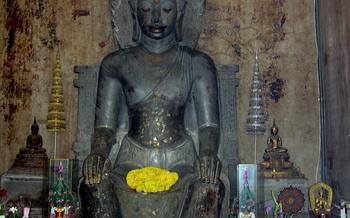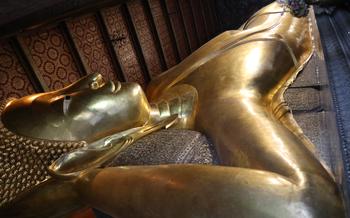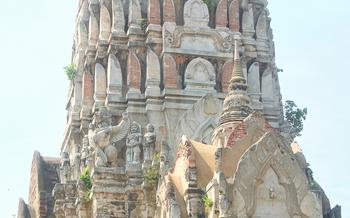
Wat Phu Dan Tae (Wat Phu Dan Tai)
- History of the temple
- Getting There
- Entrance Fees and Visiting Hours
- Things to See and Do
- Temple Complex
- Temple's History
- Architectural Style
- Religious Significance
- Statues and Images
- Murals and Paintings
- Ubosot and Ordination Hall
- Chedi and Stupas
- Festivals and Events
- Visitor Tips
- Insider Tip
History of the temple
Wat Phu Dan Tae, also known as Wat Phudon Thani province, Thailand. The temple is believed to have been built in the 16th century, during the reign of King Maha Chakkrapat of the Ayutthaya Kingdom. It is said that the temple was built by a group of monks who were fleeing from the Burmese invasion of Ayutthaya. The monks settled in the Nong Han area and built the temple as a place of worship.
The temple's name, Wat Phu Dan Tae, means "the temple on the red mountain." This name is derived from the fact that the temple is located on a hill that is made of red sandstone. The hill is about 100 meters high and offers stunning views of the surrounding countryside.
The temple is an important religious site for the people of Nong Han. It is also a popular tourist destination, as it is one of the most well-preserved ancient temples in the region.
Getting There
Wat Phu Dan Tae is located in the Ban Dung District of Udon Thani province, in northeastern Thailand. It is about 40 kilometers from the city center and can be easily reached by car or taxi. The temple is situated in a rural area, surrounded by lush green rice fields and quaint villages.
To get to the temple from Udon Thani city, you can take a taxi or rent a car and drive along Highway 2 towards Ban Dung. There are also public buses that run from Udon Thani to Ban Dung, but they may not be as frequent. From Ban Dung, follow the signs to Wat Phu Dan Tae, which is about 10 kilometers from the town.
The distance from Bangkok to Wat Phu Dan Tae is approximately 550 kilometers, which takes about 8 hours by car. Visitors can also take a flight from Bangkok to Udon Thani, which takes about 1 hour, and then take a taxi or rent a car to get to the temple.
Entrance Fees and Visiting Hours
Visiting Wat Phu Dan Tae is a budget-friendly experience, with an entrance fee of 50 baht for foreign tourists. This small fee contributes to the temple's upkeep and preservation efforts.
The temple is open to visitors daily from 8:00 AM to 5:00 PM. However, it's worth noting that the most serene and picturesque time to visit is early in the morning, before the crowds arrive. The soft golden light of the rising sun beautifully illuminates the temple's intricate carvings and statues, creating a magical atmosphere.
If you're planning your visit during Thailand's peak tourist season, which typically falls between November and February, it's advisable to arrive early to avoid long queues and crowds. Alternatively, consider visiting during the shoulder months (March-April and September-October) or the green season (May-October) to enjoy a more tranquil experience and take your time exploring the temple's grounds.
Wat Phu Dan Tae doesn't host any special events or ceremonies regularly. However, during significant Buddhist holidays such as Visakha Bucha Day (celebrating Buddha's birth, enlightenment, and passing into Nirvana) and Magha Puja Day (commemorating the Buddha's first sermon to 1,250 enlightened disciples), the temple may organize special ceremonies or merit-making activities. These events offer a unique opportunity for visitors to witness and participate in traditional Buddhist rituals and gain insights into Thai culture and religious practices.
Things to See and Do
The main highlights of the temple are its stunning architecture, intricate carvings, and beautiful murals. Visitors can explore the temple grounds, admire the various statues and images, and take advantage of the numerous photography opportunities. Other activities that can be enjoyed at the temple include meditation, chanting, and attending Buddhist ceremonies. There are also several souvenir shops located on the temple grounds, where visitors can purchase items such as Buddha statues, amulets, and religious books.
Temple Complex
The Wat Phu Dan Tae is comprised of a complex of several buildings and structures, each serving a distinct purpose within the temple grounds. Central to the complex is the Ubosot, or ordination hall, where important Buddhist ceremonies and rituals take place. The Ubosot is typically the largest and most ornate building in the temple, with intricate decorations and a Buddha statue enshrined within.
Surrounding the Ubosot are several Chedi, or stupas, which are tall, bell-shaped structures that serve as reliquaries or monuments to important figures. The Chedi at Wat Phu Dan Tae vary in size and design, with some featuring intricate carvings and colorful tiles.
Other structures within the temple complex include the Sala, or assembly hall, where monks and visitors gather for meetings or ceremonies. There may also be a Wihan, or image house, which houses additional Buddha statues and serves as a place for meditation and prayer.
The temple grounds are often adorned with lush gardens, ponds, and sculptures, creating a serene and contemplative atmosphere. Visitors can explore the complex at their own pace, taking in the beauty of the architecture and the tranquility of the surroundings.
Temple's History
The history of Wat Phu Dan Tae is shrouded in mystery and legend. According to local folklore, the temple was founded by a group of monks who were searching for a sacred site to build a monastery. One night, they had a dream in which a golden Buddha appeared to them, indicating the location of the future temple. The monks followed the dream's guidance and discovered a beautiful hilltop with a natural cave. They believed that this was the sacred site they had been seeking, and they began to build the temple.
Over the centuries, the temple has undergone several renovations and expansions. In the 19th century, the temple was renovated and expanded by King Rama V, who added several new buildings and structures. The temple was further renovated in the 20th century, when a new Ubosot (ordination hall) and a Chedi (stupa) were built. Today, Wat Phu Dan Tae is a vibrant and active temple, attracting visitors from all over the world.
Architectural Style
Wat Phu Dan Tae showcases a unique blend of architectural styles, reflecting the rich cultural heritage of the region. The temple's design incorporates elements from both Lanna and Khmer cultures, resulting in a distinctive and harmonious visual masterpiece. The Lanna influence is evident in the intricate wood carvings, ornate decorations, and the sweeping roofs that adorn the temple's structures. The Khmer influence, on the other hand, manifests in the temple's towering spires, intricate bas-reliefs, and the overall layout of the temple complex. This fusion of architectural styles creates a captivating and visually stunning experience for visitors.
The temple's main chedi, known as the Phra That Phu Dan Tae, is a prime example of the fusion of Lanna and Khmer architectural elements. The chedi's base features intricate carvings and sculptures depicting scenes from Buddhist mythology, a hallmark of Lanna artistry. As the chedi rises, it transitions into a more Khmer-inspired design, with towering spires and delicate finials that reach towards the sky. This harmonious blend of styles creates a visually striking monument that is both awe-inspiring and serene.
Religious Significance
Wat Phu Dan Tae holds immense religious significance in Buddhism. It is believed to be a sacred pilgrimage site for Buddhist devotees from Thailand and neighboring countries. Pilgrims visit the temple to pay homage to the revered Buddha image enshrined within its walls. The temple serves as a center for meditation and spiritual reflection, attracting individuals seeking inner peace and enlightenment.
One of the most significant religious events held at Wat Phu Dan Tae is the annual "Phra That Phu Dan Tae Festival." This festival takes place during the fourth week of February and commemorates the founding of the temple. During this grand celebration, thousands of devotees gather to participate in merit-making ceremonies, offer prayers, and receive blessings from monks. The festival features colorful processions, cultural performances, and traditional rituals that showcase the rich Buddhist heritage of the region.
Statues and Images
The main Buddha statue at Wat Phu Dan Tae is a colossal, golden figure seated in a serene meditation posture. The statue is known for its intricate details and serene expression, attracting pilgrims and visitors alike. Its size and grandeur are awe-inspiring, and its presence fills the temple with a sense of peace and tranquility.
Apart from the main Buddha statue, there are numerous other statues and images found throughout the temple grounds. These include smaller Buddha statues, depictions of various deities, and mythical creatures. Each statue has its own unique features and symbolism, adding to the richness and diversity of the temple's iconography.
The statues at Wat Phu Dan Tae are not merely decorative elements; they hold deep religious and cultural significance. They represent the various aspects of Buddhism and are revered by the local community. Visitors can learn about the different deities and their roles in Buddhist mythology by observing the statues and asking questions to the temple's monks or guides.
The artistic significance of the statues is also noteworthy. Many of them are finely crafted and display exquisite craftsmanship. The attention to detail and the use of traditional techniques make these statues true works of art. Visitors with an appreciation for art and culture will find much to admire in the statues at Wat Phu Dan Tae.
Murals and Paintings
The temple is adorned with intricate murals and paintings that depict scenes from Buddhist mythology and the life of Buddha. The most notable mural is located in the main prayer hall, where it covers the entire back wall. This mural portrays the story of Buddha's life, from his birth as Prince Siddhartha to his attainment of enlightenment and his subsequent teachings. The murals are painted in a traditional Thai style, with vibrant colors and intricate details.
Another notable mural is located in the ordination hall, where it depicts the ordination ceremony of a young monk. This mural is significant as it provides a glimpse into the traditional Buddhist rituals and ceremonies that are still practiced today. The murals and paintings in Wat Phu Dan Tae are not only beautiful works of art, but they also serve to educate and inspire visitors about the teachings of Buddhism.
Ubosot and Ordination Hall
The Ubosot, also known as the Ordination Hall, is a sacred and significant building within the temple complex. It serves as the primary space for religious ceremonies, including ordinations, monkhood initiations, and important Buddhist rituals. The Ubosot is typically located at the heart of the temple grounds and is often the largest and most ornate structure.
The architectural features of the Ubosot vary depending on the temple's history and cultural influences. Common features include a rectangular or square shape, a raised platform, and a distinctive roof design. The interior of the Ubosot is typically adorned with intricate murals, paintings, and sculptures depicting scenes from Buddhist mythology and history. The altar, where the Buddha image is enshrined, is the focal point of the Ubosot and is often elaborately decorated.
Visitors to the Ubosot are expected to observe respectful behavior and customs. Removing shoes and maintaining a quiet and contemplative demeanor is considered appropriate. Photography may be restricted or prohibited in some Ubosots, so it's important to follow the guidelines posted at the entrance.
By visiting the Ubosot, visitors gain a deeper understanding of the religious significance of the temple and the important role it plays in the community. It offers a glimpse into the spiritual practices and traditions that have shaped Thai culture and Buddhism.
Chedi and Stupas
Within the temple grounds, visitors can find several impressive chedi (Buddhist stupas) that hold deep religious significance. These towering structures, adorned with intricate carvings and vibrant colors, serve as symbolic representations of the Buddha's teachings and the path to enlightenment. The chedi at Wat Phu Dan Tae are particularly notable for their unique architectural styles, which blend traditional Thai elements with influences from neighboring countries. Visitors can admire their graceful spires, delicate stupas, and intricate bas-reliefs, which depict scenes from Buddhist mythology and the life of the Buddha. Exploring these chedi offers a glimpse into the rich history and cultural heritage of the temple and provides an opportunity for visitors to deepen their understanding of Buddhist beliefs and practices.
Festivals and Events
The Wat Phu Dan Tae is a vibrant center of religious and cultural celebrations throughout the year. One of the most significant events is the annual temple fair, held during the Songkran festival in April. This lively festival marks the Thai New Year and features colorful parades, traditional music and dance performances, and a variety of food and craft stalls. Visitors can immerse themselves in the festive atmosphere and experience the temple's vibrant energy firsthand.
Another notable event is Visakha Bucha, celebrated in May, which commemorates the birth, enlightenment, and passing of Lord Buddha. Devotees gather at the temple to offer prayers, light candles, and participate in merit-making activities. The temple grounds are adorned with beautiful decorations, and a special sermon is delivered by the head monk.
During Kathina, a festival held in October or November, the temple community comes together to offer new robes to the monks. This ceremony symbolizes the end of the Buddhist Lent period and is marked by colorful processions, chanting, and the presentation of offerings. Visitors can witness this unique tradition and learn more about the significance of Kathina in Thai culture.
Visitor Tips
When visiting Wat Phu Dan Tae, it is important to observe proper etiquette and customs to show respect for the sacred site. Visitors should dress modestly, covering their shoulders and knees, and remove their shoes before entering the temple grounds. It is also important to maintain a respectful demeanor, avoiding loud noises or disruptive behavior. Photography is generally allowed in the temple, but it is important to be mindful of the privacy of others and to avoid taking photos of monks or nuns without their permission.
Here are some additional tips for a meaningful visit to Wat Phu Dan Tae: - Arrive early in the morning or late in the afternoon to avoid the crowds and enjoy the peaceful atmosphere of the temple. - Take your time to explore the temple grounds and appreciate the intricate details of the architecture and artwork. - If you are fortunate enough to visit during a festival or ceremony, be sure to participate in the festivities and learn about the unique traditions of the temple. - Be sure to visit the nearby village of Ban Phu Dan Tae to experience the local culture and way of life.
Insider Tip
Beyond the main temple complex, there are several hidden gems worth exploring. Seek out the secluded meditation cave, nestled amidst the surrounding hills, where you can find tranquility and a deeper connection to the temple's spiritual essence.
For a breathtaking panorama, venture to the viewpoint located atop a nearby hill. The panoramic vistas of the temple grounds and the surrounding countryside will leave you in awe.
Uncover the temple's captivating history by engaging with the local monks or knowledgeable guides. They can share intriguing stories and legends passed down through generations, enriching your understanding of the temple's significance.
Extend your exploration to the nearby village, where you can immerse yourself in the local culture. Interact with the friendly villagers, savor delicious regional cuisine, and discover hidden culinary gems.
Remember to embrace the temple's serene atmosphere and practice mindfulness throughout your visit. Let the tranquility of the surroundings envelop you, creating a lasting memory of your journey to Wat Phu Dan Tae.




